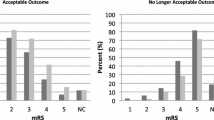Abstract
Background
The assumption is often made that aggressive care in the form of early decompressive hemicraniectomy is appropriate for young patients who suffer a massive stroke. However, neither their attitude toward aggressive treatment, nor their perception of acceptable quality of life after a stroke, has been adequately studied.
Methods
We conducted a cross-sectional questionnaire-based survey that consisted of demographic information and attitude toward neurological disability based on the highest acceptable modified Rankin Scale (mRS) that they would be “willing to live with.” Young adults in the Los Angeles County were surveyed and grouped by whether or not they would want early decompressive hemicraniectomy after a massive stroke. Logistic regression analysis was used to determine the factors associated with willingness to accept decompressive hemicraniectomy.
Results
Sixty-eight community-dwelling young adults (mean age: 24 ± 6 years) were surveyed. The highest acceptable mRS (0–5) participants felt “willing to live with” were: 10.3% (0), 29.4% (1), 27.9% (2), 20.6% (3), 8.8% (4), 2.9% (5). Despite being presented with a hypothetical high likelihood of long-term disability, 46 of 68 (68%) reported they would undergo hemicraniectomy. Neither the demographic factors nor the highest acceptable mRS was associated with the willingness to seek decompressive hemicraniectomy.
Conclusion
Our study supports the commonly held assumption that the majority of young adults would favor early decompressive hemicraniectomy after a massive ischemic stroke. We also show that a substantial minority in this age group is reluctant to accept this aggressive measure, emphasizing the importance of discussing the individual’s previously stated wishes, even in the young population.

Similar content being viewed by others

References
Varona JF, Guerra JM, Bermejo F. Stroke in young adults. Med Clin (Barc). 2004;122:70–4.
Rasura M, Spalloni A, Ferrari M, et al. A case series of young stroke in Rome. Eur J Neurol. 2006;13:146–52.
Kwon SU, Kim JS, Lee JH, Lee MC. Ischemic stroke in Korean young adults. Acta Neurol Scand. 2000;101:19–24.
Alvarez J, Matias-Guiu J, Sumalla J, et al. Ischemic stroke in young adults. I. Analysis of the etiological subgroups. Acta Neurol Scand. 1989;80:28–34.
Sloan MA, Kittner SJ, Feeser BR, et al. Illicit drug-associated ischemic stroke in the Baltimore–Washington Young Stroke Study. Neurology. 1998;50:1688–93.
Kittner SJ, Stern BJ, Wozniak M, et al. Cerebral infarction in young adults: the Baltimore–Washington Cooperative Young Stroke Study. Neurology. 1998;50:890–4.
Kristensen B, Malm J, Carlberg B, et al. Epidemiology and etiology of ischemic stroke in young adults aged 18 to 44 years in northern Sweden. Stroke. 1997;28:1702–9.
Bogousslavsky J, Pierre P. Ischemic stroke in patients under age 45. Neurol Clin. 1992;10:113–24.
Adams HP Jr, Kappelle LJ, Biller J, et al. Ischemic stroke in young adults. Experience in 329 patients enrolled in the Iowa Registry of stroke in young adults. Arch Neurol. 1995;52:491–5.
Bogousslavsky J, Regli F. Ischemic stroke in adults younger than 30 years of age. Cause and prognosis. Arch Neurol. 1987;44:479–82.
Varona JF, Guerra JM, Bermejo F, Molina JA, Gomez de la Camara A. Causes of ischemic stroke in young adults, and evolution of the etiological diagnosis over the long term. Eur Neurol. 2007;57:212–8.
Nencini P, Inzitari D, Baruffi MC, et al. Incidence of stroke in young adults in Florence, Italy. Stroke. 1988;19:977–81.
Marini C, Totaro R, De Santis F, Ciancarelli I, Baldassarre M, Carolei A. Stroke in young adults in the community-based L’Aquila registry: incidence and prognosis. Stroke. 2001;32:52–6.
Putaala J, Curtze S, Hiltunen S, Tolppanen H, Kaste M, Tatlisumak T. Causes of death and predictors of 5-year mortality in young adults after first-ever ischemic stroke: the Helsinki Young Stroke Registry. Stroke. 2009;40:2698–703.
Varona JF, Bermejo F, Guerra JM, Molina JA. Long-term prognosis of ischemic stroke in young adults. Study of 272 cases. J Neurol. 2004;251:1507–14.
Kappelle LJ, Adams HP Jr, Heffner ML, Torner JC, Gomez F, Biller J. Prognosis of young adults with ischemic stroke. A long-term follow-up study assessing recurrent vascular events and functional outcome in the Iowa Registry of Stroke in Young Adults. Stroke. 1994;25:1360–5.
Naess H, Waje-Andreassen U, Thomassen L, Nyland H, Myhr KM. Health-related quality of life among young adults with ischemic stroke on long-term follow-up. Stroke. 2006;37:1232–6.
Neau JP, Ingrand P, Mouille-Brachet C, et al. Functional recovery and social outcome after cerebral infarction in young adults. Cerebrovasc Dis. 1998;8:296–302.
Hacke W, Schwab S, Horn M, Spranger M, De Georgia M, von Kummer R. ‘Malignant’ middle cerebral artery territory infarction: clinical course and prognostic signs. Arch Neurol. 1996;53:309–15.
Berrouschot J, Sterker M, Bettin S, Koster J, Schneider D. Mortality of space-occupying (‘malignant’) middle cerebral artery infarction under conservative intensive care. Intensive Care Med. 1998;24:620–3.
Vahedi K, Hofmeijer J, Juettler E, et al. Early decompressive surgery in malignant infarction of the middle cerebral artery: a pooled analysis of three randomised controlled trials. Lancet Neurol. 2007;6:215–22.
Gupta R, Connolly ES, Mayer S, Elkind MS. Hemicraniectomy for massive middle cerebral artery territory infarction: a systematic review. Stroke. 2004;35:539–43.
Gerhart KA, Koziol-McLain J, Lowenstein SR, Whiteneck GG. Quality of life following spinal cord injury: knowledge and attitudes of emergency care providers. Ann Emerg Med. 1994;23:807–12.
Author information
Authors and Affiliations
Corresponding author
Rights and permissions
About this article
Cite this article
Nakagawa, K., Bianchi, M.T., Nakagawa, S.S. et al. Aggressive Care After a Massive Stroke in Young Patients: Is That What They Want?. Neurocrit Care 13, 118–122 (2010). https://doi.org/10.1007/s12028-010-9340-7
Published:
Issue Date:
DOI: https://doi.org/10.1007/s12028-010-9340-7



